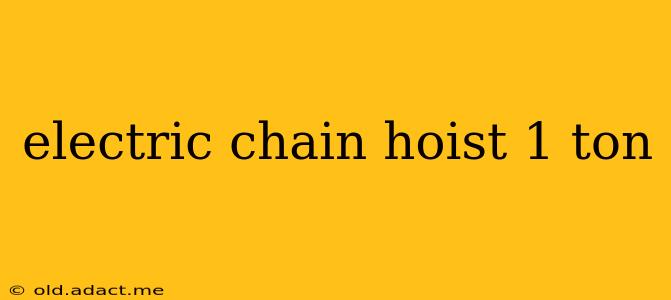Choosing the right electric chain hoist is crucial for ensuring safe and efficient lifting operations. A 1-ton electric chain hoist is a popular choice for various applications, from workshops and factories to construction sites and warehouses. This comprehensive guide delves into the essential aspects of selecting, using, and maintaining a 1-ton electric chain hoist. We’ll cover everything from key features and safety considerations to troubleshooting and maintenance tips.
What are the Different Types of 1-Ton Electric Chain Hoists?
Electric chain hoists come in several varieties, each designed for specific needs and environments. Understanding these differences is crucial for making the right choice. Key distinctions often include:
-
Single-Phase vs. Three-Phase: Single-phase hoists are suitable for lighter-duty applications and are commonly found in smaller workshops or garages where three-phase power isn't available. Three-phase hoists offer higher power and are better suited for heavy-duty applications and continuous use. A 1-ton hoist could be either, depending on the intended use.
-
Wired vs. Wireless: Wired hoists offer reliable power and control but limit mobility. Wireless hoists provide greater flexibility but require careful battery management and may have limitations on lifting capacity or duty cycle.
-
Fixed vs. Portable: Fixed hoists are permanently mounted to an overhead track system, offering the best lifting stability and often higher lifting capacities. Portable hoists are more versatile but may require more secure mounting to ensure safety.
What are the Key Features to Look for in a 1-Ton Electric Chain Hoist?
Several key features should be considered when selecting a 1-ton electric chain hoist to ensure it meets your specific needs and prioritizes safety:
-
Lifting Capacity: While this is specified (1 ton), ensure the hoist's rated capacity comfortably exceeds your anticipated load. Allowing for a safety margin is crucial.
-
Lifting Speed: Faster lifting speeds can increase productivity, but excessively fast speeds can compromise safety. Consider the balance between speed and safety for your specific application.
-
Motor Type: Different motor types offer varying performance and durability. Look for information on motor type, duty cycle, and thermal protection.
-
Safety Features: Essential safety features include overload protection, emergency stop buttons, and limit switches to prevent over-lifting or dropping the load.
-
Chain Grade: The grade of the chain indicates its strength and durability. Higher grades offer greater safety and longevity.
How Much Does a 1-Ton Electric Chain Hoist Cost?
The cost of a 1-ton electric chain hoist varies significantly depending on the features, brand, and supplier. Prices can range from a few hundred dollars for basic models to several thousand dollars for heavy-duty, high-performance hoists. It's crucial to compare features and specifications before making a purchase decision. Don't solely focus on the lowest price; prioritize safety and quality.
What are the Maintenance Requirements for a 1-Ton Electric Chain Hoist?
Regular maintenance is essential to ensure the safety and longevity of your 1-ton electric chain hoist. This includes:
-
Regular Inspections: Conduct visual inspections before each use, checking for damage to the chain, hooks, and other components.
-
Lubrication: Regular lubrication of the chain and moving parts is vital to prevent wear and tear.
-
Chain Replacement: Replace the chain if it shows significant wear or damage. A worn chain can significantly reduce the hoist's lifting capacity and pose a serious safety risk.
-
Professional Servicing: Regular professional servicing is recommended to ensure the hoist remains in safe working order.
What Safety Precautions Should I Take When Using a 1-Ton Electric Chain Hoist?
Safety should always be the top priority when operating any lifting equipment. Here are key safety precautions to follow:
-
Proper Training: Only trained and authorized personnel should operate the hoist.
-
Load Capacity: Never exceed the hoist's rated lifting capacity.
-
Proper Load Handling: Ensure the load is properly secured and balanced before lifting.
-
Inspection: Inspect the hoist thoroughly before each use.
-
Emergency Stop: Be familiar with the location and operation of the emergency stop button.
-
Personal Protective Equipment (PPE): Always wear appropriate PPE, including safety glasses and gloves.
How Do I Choose the Right Electric Chain Hoist for My Needs?
Selecting the right 1-ton electric chain hoist requires careful consideration of your specific application and needs. Factors to consider include:
-
Lifting Height: Determine the maximum lifting height required.
-
Duty Cycle: Consider how frequently the hoist will be used. Heavy-duty hoists are designed for more continuous operation.
-
Power Supply: Ensure the hoist's power requirements match your available power supply.
-
Environmental Conditions: Consider the operating environment. Some hoists are better suited for harsh conditions than others.
By carefully considering these factors and prioritizing safety, you can select a 1-ton electric chain hoist that meets your specific needs and ensures safe and efficient lifting operations for years to come. Remember to always consult the manufacturer's instructions for specific operating procedures and maintenance recommendations.
